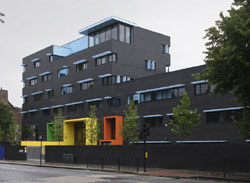NEWSLETTER JANUARY 2008©
NEWS |
MORE NEWS |
Meeting of the Camberwell Grove working groupThe meeting took place at 6pm on Thursday 31st January 2008. The meeting was chaired by Paul Noblet, who has the final authority on whether the works should go ahead. Andrew Downes, Street Scene Manager at Southwark Council, was present to explain the traffic planners' position. The meeting was also attended by councillors representing both Camberwell Grove and The Lanes. In addition, about a dozen residents, mainly from Camberwell Grove, but also a few from Lyndhurst Grove and Grove Park were in attendence. The purpose of the meeting was to conside a proposal put forward by the Camberwell Grove residents to consider the reopening of the bridge to one-way traffic only, from the top to the bottom of the Grove. Mr Downes had been asked to consider and respond to this proposal, which he did. He conculded that one-way traffic was NOT viable for a number of reasons. These included:
Andrew Downes also pointed out that these problems were largely the same as all proposals previously put forward not involving traffic lights. He had therefore concluded, with reluctance, that the only way that Southwark can comply with its statutory duty to reopen the bridge as nearly as possible to its previous state was to install traffic lights. Naturally the Camberwell Grove representatives were deeply unhappy about this conclusion, and the rare constructive criticism cited a lack of imagination by the council in trying to deal with the bridge restriction. The discussion that followed achieved little save to allow all present to vent their undoubted frustration. Prior to reopening, traffic cushions will be put in place at the top of the grove. In addition, to prevent oversized traffic from entering the Grove to being with, width restrictors MAY be put in place at each end of the Grove. We must lobby Paul Noblet and Andrew Downes to get these width restrictors in place before the bridge opens. After all, if they had been put in back in the 1990s, then the bridge would not have been damaged by oversized traffic to begin with!! The meeting then discussed how and when the bridge might be fully repaired. This is not as easy as simply lobbying Network Rail. This is becasue although Network Rail has a responsibility to maintain the bridge, it can refuse to replace/fully repair it unless funds are made available from Transport for London (TfL). (Because it was a change in governement policy that required these Victorian bridges to take increased weight, a purpose for which they were not designed). TfL dole out funds for bridge repairs / replacements in order of prioroty, and this is allocated on a London-wide basis through a working group on which every borough is represented. So for example, the current repairs on the Red Post Hill bridge is further up the pecking order and has been funded because it has a bus route. |
Camberwell Grove Railway Bridge Continued...Once the traffic lights are in place, we should aim to work closely and constructively with Camberwell Grove to lobby TfL to allocate funds to Network Rail to fully repair or replace the bridge. However - one step at a time - let's get to this once the bridge has reopened. Finally, Mr Noblett closed the meeting with a decision that the traffic light solution would go ahead, its performance would be monitored and reviewed. He also agreed traffic monitoring at the ends of the Grove to see how the bridge opening affects the traffic. SUNSHINE HOUSE 
Sunshine House - Southwark children and young people's new development centre opened its doors in November 2007 at Costing £8.5m, the new building on the corner of St Giles Road and Peckham Road brings together a range of specialist services for children and young people with special needs, disabilities and complex needs, in one new, purpose built place, which will save on administrative costs. This is a genuine example of JOINED UP THINKING. Guy's and St Thomas's Charity funded the stunning art projects that enhance the interior - from thought-provoking inscriptions dotted around the building to the stellar-like sculpture and colourful paintings. The building was developed by Southwark Primary Care Trust with Building Better Health - Lambeth, Southwark, Lewisham Ltd. Its facilities include a gymnasium, sensory, consulting. therapy and observation rooms, enclosed garden with play equipment and a soft play room. For more information call 020 3049 8100 or go to their website. POLICE REVIEW The main problems seem to be
The current police stations are not in the right places or cannot be altered to comply with disability access rules or changes of policing methods. The proposal for Camberwell is to have new front desk policed more than Camberwell Police Station at 121, Denmark Hill, which is on the corner of Champion Hill opposite Ruskin Park. This building is already the base for a Safer Neighbourhood team, although there is not front counter service. If you have any feelings about policing in Camberwell and would like to comment on these proposals send your comments to Or contact the Safer Neighbourhood Team via email |
Click here to return to the Home Page | WILSON’S RESIDENTS ASSOCIATION Secretary, 24A Wilson Road, SE5 Tel: 0207 701 9313 wilsonsra@hotmail.com ©Copyright Calista Lucy 2008 All Rights Reserved. |